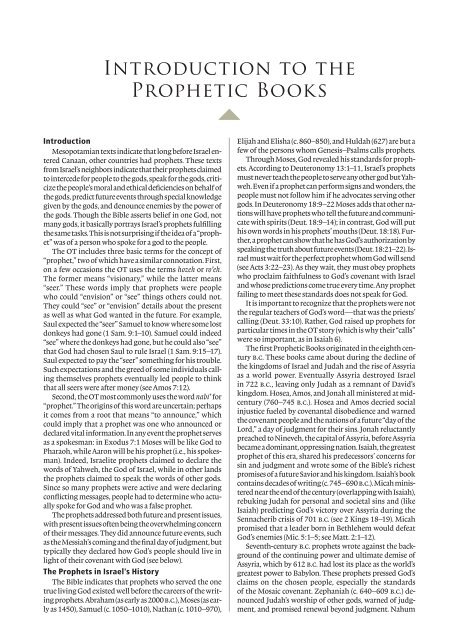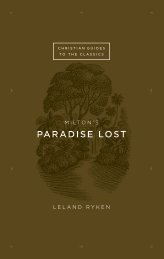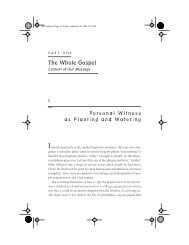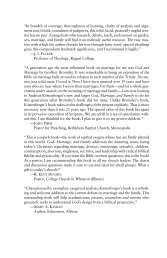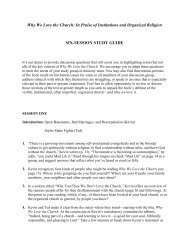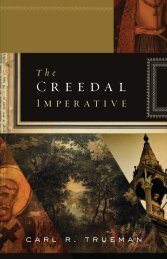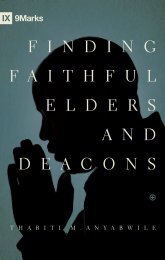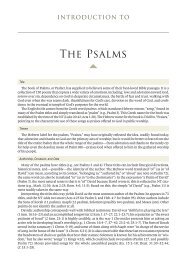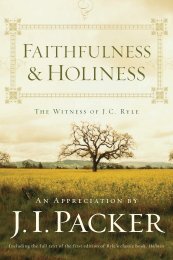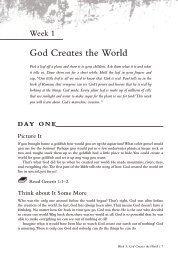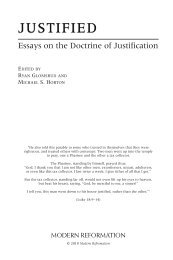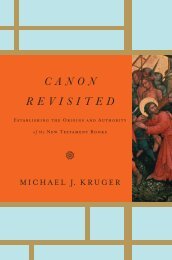Introduction to the Prophetic Books - Monergism Books
Introduction to the Prophetic Books - Monergism Books
Introduction to the Prophetic Books - Monergism Books
Create successful ePaper yourself
Turn your PDF publications into a flip-book with our unique Google optimized e-Paper software.
<strong>Prophetic</strong> <strong>Books</strong>1230(c. 660–630 b.c.) announced <strong>the</strong> end of Assyria’s tyranny,and Habakkuk (c. 640–609) explored <strong>the</strong> ways of God in <strong>the</strong>days leading up <strong>to</strong> Babylon’s capturing of Judah. Of course,Jeremiah also worked during this century and well in<strong>to</strong> <strong>the</strong>next. He declared God’s word of repentance <strong>to</strong> Judah for atleast 40 years (627–587 b.c.; Jer. 1:1–3), decades that spannedfrom <strong>the</strong> period when Judah still had time <strong>to</strong> change itsways and avoid punishment, <strong>to</strong> <strong>the</strong> destruction of Jerusalemby Babylon in 587 and <strong>the</strong> subsequent exiling of <strong>the</strong>people. He repeatedly preached repentance, yet his mostfamous words are <strong>the</strong> promise of a future new covenantwith <strong>the</strong> house of Israel (Jer. 31:31–34; see Heb. 8:8–12).Sixth-century b.c. prophets lived under <strong>the</strong> shadowof exile. A few of <strong>the</strong>m also lived during <strong>the</strong> shifting ofworld domination from Babylon <strong>to</strong> Persia, which occurredin 538 b.c. Daniel was taken <strong>to</strong> Babylon in 605 b.c.He worked <strong>the</strong>re until at least 536 b.c. Ezekiel joined <strong>the</strong>exiles in Babylon in 597 b.c., where he wrote accounts ofvisions he received during 593–571. Both of <strong>the</strong>se exilesenvisioned perilous times and future days of glory forGod’s people. Obadiah witnessed <strong>the</strong> terrors of Babylon’sinvasion of Judah in 587 b.c. Haggai and Zechariah wereamong <strong>the</strong> people allowed <strong>to</strong> return <strong>to</strong> Jerusalem fromPersia in 520–516 b.c. They participated in <strong>the</strong> rebuildingof <strong>the</strong> temple and looked forward <strong>to</strong> future glory for God’speople under <strong>the</strong> Messiah’s leadership.Malachi served during <strong>the</strong> fifth century b.c. A contemporaryof Ezra and Nehemiah (c. 460–425 b.c.), he experienced<strong>the</strong> problems associated with rebuilding Jerusalemand res<strong>to</strong>ring faithful worship and covenantal obedience.Malachi identified flaws in <strong>the</strong> returned exiles’ commitment<strong>to</strong> God, such as insincere worship, <strong>the</strong> failure of <strong>the</strong>priests <strong>to</strong> teach God’s Word, and marital infidelity (Mal.1:6–2:16). He also predicted <strong>the</strong> coming of a new Elijahand <strong>the</strong> Messiah (Mal. 4:5–6). The book of Joel probablycomes from this period as well, as it makes no mentionof a king in Judah. Joel calls <strong>the</strong> people <strong>to</strong> repentance at atime of national calamity (a locust plague).<strong>Prophetic</strong> <strong>Books</strong>Little is known about <strong>the</strong> <strong>Prophetic</strong> <strong>Books</strong>’ compositionand preservation, though some helpful information maybe gleaned from <strong>the</strong> biblical text. For example, Isaiah haddisciples who were able <strong>to</strong> preserve his words (Isa. 8:16),and Jeremiah’s disciple Baruch was a scribe who wrotedown some of <strong>the</strong> prophet’s messages (Jer. 36:1–32). Manyprophets were probably able <strong>to</strong> write <strong>the</strong>ir own words (Isa.8:1–2; Jer. 1:4–19) since literacy was fairly widespread.The prophets’ words were originally copied on papyrusor lea<strong>the</strong>r scrolls that were passed on <strong>to</strong> future generationsby persons who valued <strong>the</strong>m (Jer. 36:1–4). Several suchbooks existed at one time, for <strong>the</strong> author of 1–2 Chroniclesreports sources composed by or about prophets (1 Chron.29:29; 2 Chron. 9:29; 26:22). By Jeremiah’s time <strong>the</strong> prophecyof Micah had been handed down and was consideredauthoritative (Jer. 26:13, quoting Mic. 3:12). According<strong>to</strong> <strong>the</strong> apocryphal book Sirach, by <strong>the</strong> second century b.c.(at <strong>the</strong> very latest) all <strong>the</strong> <strong>Prophetic</strong> <strong>Books</strong> were consideredauthoritative Scripture (see Sir. 48:22; 49:6, 8, 12;cf. 1 Macc. 2:60).Many types of literature appear in <strong>the</strong> <strong>Prophetic</strong> <strong>Books</strong>.There are narratives detailing what <strong>the</strong> prophets did and<strong>the</strong> circumstances in which <strong>the</strong>y received and delivered<strong>the</strong>ir messages. There are also sermons, extended poems,dialogues between God and prophets, and visionary experiences.All of <strong>the</strong>se forms reveal <strong>the</strong> great <strong>the</strong>mes notedin <strong>the</strong> next section, and <strong>the</strong>se <strong>the</strong>mes provide <strong>the</strong> books’plot (or s<strong>to</strong>ry line) and major characters.Unifying Themes in <strong>the</strong> <strong>Prophetic</strong> <strong>Books</strong>The <strong>Prophetic</strong> <strong>Books</strong> include most of <strong>the</strong> OT’s greatest<strong>the</strong>mes, preserving in written form for future generations<strong>the</strong> reasons Israel’s his<strong>to</strong>ry happened as it did. Though <strong>the</strong>authors wrote in different times and under different circumstances,<strong>the</strong>ir messages are in <strong>the</strong>ological harmonywith one ano<strong>the</strong>r and with o<strong>the</strong>r types of biblical books.Several interrelated ideas unify <strong>the</strong> prophetic message,making it possible for readers <strong>to</strong> find <strong>the</strong>ir bearings insome difficult literature. It is often helpful <strong>to</strong> decide whichof <strong>the</strong> following <strong>the</strong>mes <strong>the</strong> biblical author is stressingwhen one becomes puzzled by <strong>the</strong> content of <strong>the</strong> books.First, <strong>the</strong> prophets assert that God has spoken through <strong>the</strong>m.They clearly considered <strong>the</strong>mselves God’s messengers andheralds, for <strong>the</strong>y repeatedly preface <strong>the</strong>ir messages with<strong>the</strong> phrase, “Thus says Yahweh.” In this way <strong>the</strong> prophetsare claiming that <strong>the</strong>ir books are <strong>the</strong> written word of God.Peter explains that <strong>the</strong> prophets “were carried along by <strong>the</strong>Holy Spirit” (2 Pet. 1:21). Just as God used Moses <strong>to</strong> writeand preach so that Israel could know God’s will in his era,so God used <strong>the</strong> prophets in <strong>the</strong>ir generations. The prophetsdeclared God’s instructions in two basic ways: word andsymbol. Usually <strong>the</strong> prophets presented God’s word orally(e.g., Jer. 7:1–8:3) or in written form (e.g., Jer. 36:1–32) <strong>to</strong>varying types and sizes of audiences. Occasionally <strong>the</strong>y performedsymbolic acts that demonstrated God’s purposes.For example, Isaiah went naked and barefoot for threeyears <strong>to</strong> teach God’s people <strong>the</strong>ir future if <strong>the</strong>y continued<strong>to</strong> seek help from o<strong>the</strong>r nations ra<strong>the</strong>r than from God (Isa.20:1–6). Perhaps <strong>the</strong> saddest case of symbolic prophecy wasHosea’s marriage <strong>to</strong> unfaithful Gomer, which portrayedGod’s relationship with unfaithful Israel (Hosea 1–3).Second, <strong>the</strong> prophets affirm that God chose Israel for covenantrelationship. The Pentateuch (<strong>the</strong> first five books of <strong>the</strong> OT)teaches that God chose Abraham and his family <strong>to</strong> bless allnations (Gen. 12:1–9), that he revealed salvation by grace<strong>to</strong> Abraham (Gen. 15:6), and that he assigned Moses <strong>to</strong>write a record of this revelation (Ex. 24:4). Fur<strong>the</strong>rmore,through Moses in Exodus–Deuteronomy he revealed <strong>the</strong>lifestyle that reflects that relationship. With <strong>the</strong>se truthsin mind, <strong>the</strong> prophets addressed Israel as a people withspecial responsibilities based on this special relationship(Jeremiah 2–6; Hosea 1–3; Amos 2:6–3:8; etc.). Through<strong>the</strong> prophets God revealed <strong>the</strong> success and failure of Israel’sattempts or lack of attempts <strong>to</strong> fulfill <strong>the</strong>ir confession offaith in God and <strong>the</strong>ir God-given role as a kingdom ofpriests charged with serving <strong>the</strong> nations (see Ex. 19:5–6).Third, sadly, <strong>the</strong> prophets most often report that <strong>the</strong> majorityof Israel has sinned against <strong>the</strong>ir God and his standards for<strong>the</strong>ir relationship. They have failed <strong>to</strong> trust God (Isa. 7:1–14).Thus, <strong>the</strong>y have broken <strong>the</strong> Ten Commandments (cf. Ex.20:1–17 and Jer. 7:1–15; Hos. 4:2). They have worshipedo<strong>the</strong>r gods (Ezek. 8:1–18). They have mistreated one ano<strong>the</strong>rand failed <strong>to</strong> preserve justice among God’s people(Isa. 1:21–31). They have refused <strong>to</strong> repent (Amos 4:6–11).Of course, in <strong>the</strong>se times <strong>the</strong>re was always a faithful minority,called <strong>the</strong> “remnant” (see Isa. 4:3; 10:20–22; etc.),as <strong>the</strong> prophets’ ministries <strong>the</strong>mselves demonstrate (seeHebrews 11).
<strong>Prophetic</strong> <strong>Books</strong>1232for pronouns; and (4) obscurity in a passage beyond simplyits pronouns. Also, (5) an author might be addressing <strong>the</strong>people as a whole (personified as a single “you”). The followingare examples for each scenario.(1) Who is “he” in Zechariah 10:11? The Lord speaks as “I”on ei<strong>the</strong>r side of this verse; ancient versions and commenta<strong>to</strong>rsoften read “<strong>the</strong>y” here, <strong>to</strong> link back <strong>to</strong> <strong>the</strong> last word ofZechariah 10:10. However, <strong>the</strong> context suggests that <strong>the</strong>action of Zechariah 10:10 belongs <strong>to</strong> <strong>the</strong> Lord, and in Zechariah10:12b, <strong>the</strong> Lord’s own voice seems <strong>to</strong> refer <strong>to</strong> himselfin <strong>the</strong> third person (“his name”). Here <strong>the</strong> prophet’s voiceand <strong>the</strong> Lord’s seem fused, and in spite of changing between“I” and “he/him,” <strong>the</strong> reference is consistently <strong>to</strong> God.(2) Who is “us” in Isaiah 41:22? The first-person pluralreference continues in Isaiah 41:23, and <strong>the</strong>n reappearsin Isaiah 41:26, but never with an explicit referent. Here,help comes from <strong>the</strong> wider context. The setting is <strong>the</strong> divinecourtroom (“set forth your case,” Isa. 41:21), and this is introducedat Isaiah 41:1 (“let us draw near for judgment”), so“us” in Isaiah 41:22 remains <strong>the</strong> members of <strong>the</strong> divine courtwho are hearing <strong>the</strong> case against <strong>the</strong> idols of Isaiah 41:7.(3) Who is “her” in Micah 7:10? The answer partly dependson who is “me” in Micah 7:8. “My enemy” in Micah7:8, 10 is grammatically feminine (Hb. ’oyabti), and so is<strong>the</strong> antecedent for “her” in Micah 7:10. It is likely, <strong>the</strong>n,that <strong>the</strong> first-person voice is also feminine (cf. Mic. 6:9;7:11)—Jerusalem personified. In biblical convention, citiesare referred <strong>to</strong> as feminine and nations as masculine—unlike modern English usage in which cities are normallyneuter (“it”) and nations are feminine.(4) A genuine difficulty is <strong>the</strong> “<strong>the</strong>y” (fem.) reference ofEzekiel 30:17, represented in <strong>the</strong> esv by “women” but witha textual note, “Or <strong>the</strong> cities; Hebrew <strong>the</strong>y.” The translationadopted in <strong>the</strong> text takes its cue from “young men” inEzekiel 30:17a and “daughters” of Ezekiel 30:18b. “Cities”remains possible (see example 3), as “On” and “Pi-beseth”are <strong>the</strong> closest immediate antecedents in context.(5) The prophets can personify God’s people, viewedcorporately, as if a single person. In Isaiah 41:8–10, “you”(masculine singular) refers <strong>to</strong> “Jacob,” <strong>the</strong> whole peopleportrayed as God’s “servant” (<strong>to</strong> accomplish his purposesfor <strong>the</strong> world). It is <strong>to</strong> <strong>the</strong> people viewed corporately thatGod promises, “I will streng<strong>the</strong>n you, I will help you, I willuphold you” (Isa. 41:10). Similarly, in Isaiah 49:15–16, Godaddresses “you” (this time feminine singular), a personificationof Zion (Isa. 49:14), representing <strong>the</strong> whole people(see also Isa. 54:1–17).Awareness of <strong>the</strong>se possibilities should assist <strong>the</strong> readerin untangling some of <strong>the</strong> pronoun references that mightinitially seem difficult <strong>to</strong> understand.Activity of <strong>the</strong> Writing Prophets during <strong>the</strong> Reigns of <strong>the</strong> Kings of Israel and JudahTimeline King of Judah // Event Prophet <strong>to</strong> Judah Prophet <strong>to</strong> Israel King of Israel // Event780 B.C. Jeroboam II (781–753)770760 Uzziah (c. 760) (c. 760)(Azariah) Amos Jonah(767–740)(c. 755)Hosea Zechariah (753–752)Shallum (752)750 Jotham Menahem (752–742)(750–735) Micah (c. 742) Isaiah (c. 740) Pekahiah (742–740)740 Pekah (740–732)Ahaz (735–715) Hoshea (732–722)730720 Fall of Samaria (722)710 Hezekiah (715–686)700680 Manasseh (686–642) Nahum (c. 660–630)660 Amon (642–640) Major prophets640 Josiah (640–609) Zephaniah (c. 640–609)Habakkuk (c. 640–609)620 (c. 627)600 JeremiahJehoahaz (609)Jehoiakim (609–597) (c. 605)Jehoiachin (597)DanielZedekiah (597–586) (c. 597)Fall of Jerusalem (586) Obadiah(after 586)580560540520 1st return of exiles (538) Haggai (c. 520)Temple rebuilt (516/515) Zechariah (c. 520)500480460 2nd return of exiles (458) Malachi (c. 460)440 3rd return of exiles (445)EzekielMinor prophetsJoel is not displayed as <strong>the</strong> dates areuncertain and estimates range from <strong>the</strong>9th <strong>to</strong> <strong>the</strong> 4th centuries B.C.Micah’s prophecy was likely directed<strong>to</strong>ward both Judah and Israel.


